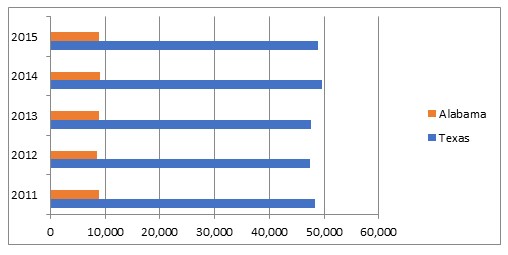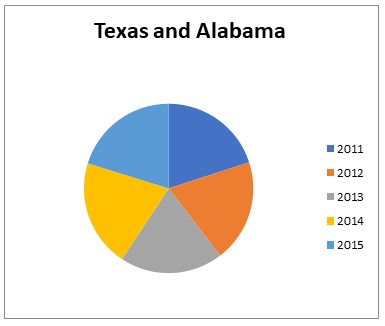Introduction
Kids Count is an internet site that compares the performance of children in various areas against children in many other areas. Over 4 million metrics and statistics on children’s and households’ well-being are housed in the cloud service (Kiryanov et al., 2017). The knowledge for the children’s data collection comes from reputable sources and agencies. It includes a number of indications that enable someone looking for information to receive the most up-to-date and accurate information they require to create and present a comparison between two different locations. The parameters encompass demographics, educational, healthcare, protection, and security concerns, among many others, and offer users to compare geographical areas that they are willing to take part in.
Kids Count also publishes policies and studies on a constant schedule on significant subjects such as fair treatment for children and early investment in children. The firm also works to ensure proper data collection by collaborating with the federal government, allowing child champions to access contextually relevant data. The proposed study is a learning tool founded on the website Kids Count. Premature births in Alabama and Texas, three peer reviewed articles and the Kids Count are the source of the information that has been used. It will compare and contrast the outcomes in the data for every state with peer-reviewed studies, as well as discuss any anomalies discovered in the dataset. Thus, the theme of premature births in Alabama and Texas should be explored using Kids Count.
Summary of Data Retrieval
When conducting comparisons involving two different locations, Kids Count gives a set of indicators from which to pick. Data analysis is a technique of assembling and comparing data from many bases in order to arrive at a reasonable conclusion from the information provided. There are two methods for gathering data: qualitative and quantitative research. Kids Count collects data from a variety of sources and stores it in a computer system. The Kids Count data book, which gives a comparison of the children’s health based on numerous factors, can provide further information. In this research, there is comparison of the rates of preterm delivery in Alabama and Texas. Preterm birth occurs when a child is born before the 37th week of pregnancy (The Kids Count). Therefore, the site helps statistically establish the rate of preterm birth.
Each time a baby is born before 37 full weeks of pregnancy, it is referred to as a preterm birth; this is approximately three weeks before the birth. This indicates that a child will not have enough time to completely develop. The graphs below present a comparison of the prevalence of preterm births from 2011 to 2015. According to the statistics, Texas has a greater rate of premature births than Alabama (Axford et al., 2019; Handayani & Watanabe, 2020). It is possible to produce charts and graphs using data obtained from the Kids Count data center to quickly display the comparison of the different places being examined.

The information presented below is associated with health statistics of premature births in Texas and Alabama from 2011 to 2015 (Handayani & Watanabe, 2020). This is a breakdown of premature births reported in different years, and a comparison is possible using this data. The information might be represented numerically or as a percentage. As previously stated, Kids Count aims to offer reliable and timely information. As an outcome, the data is obtained from the National Institute of Health. This is a government parasternal that proposes statistics on health issues to US residents in order to help them live healthier lives. As a result, the information presented is more trustworthy and this methodology shows further information.
Data is gathered from the Centers for Disease Control and Prevention’s examination of child development micro records from 1990 to 2006 (Gemmill et al., 2019). Kids Count provide an overview of child trends in relation to preterm births among US nationals. According to the findings, Texas has a greater rate of preterm birth than Alabama and this rate is over five times greater. Between 2011 and 2015 (Makani et al., 2017), the rate of preterm births increased: in Texas, for example, the statistic was 48,336 in 2011 and 48,846 in 2015 (Blickstein, 2018). Nevertheless, the population has decreased twice, between 2011 and 2012 and again in 2014 and 2015 (Russell, 2019). Moreover, there was a rise during 2012 and 2013, and a much higher rate of growth between 2013 and 2014, and Alabama also follows the same trend (Bhimji, 2017). Between 2011 and 2015, there had been an absolute rise in the number of people, with 8817 in 2011 and 8932 in 2015 (Bhimji, 2017). During 2011 and 2012, and 2014 and 2015, there was even a reduction in the amount, as well as a substantial surge between 2013 and 2014 (Russell, 2019). Thus, the statistics presented in figure 1 are heterogeneous. The figures number 2 and 3 allow to demonstrate the comparison of data according to the states.


Line graphs are by far the most effective for evaluating data between the two categories; they provide a better visual picture of the material. While opposed to pie charts and bar graphs, it is simpler to discern a small difference or variation that has happened between two points in time when utilizing line graphs. They illustrate the changes that have taken place during a certain time frame, making it easy to compare two distinct groups for the same period of time. As a result, they are the most effective way of determining the configuration or tendency shown by a set of facts. According to the statistics, there is a rising movement in the sum of premature births (Harper, 2018). The trend, on the other hand, is unpredictably unexpected. This is due to the fact that the number has fluctuated from year to year, with no discernible pattern. The pattern, on the other hand, is the same for both states, since they both reach their highs and lows in the same decades.
Three Reasons Why the Data Is Similar
For a variety of reasons, the two patterns are comparable. Changes in obstetrics, generational reproduction, and family planning are among them. The changing obstetrics has led to the majority of women in both states preferring C-section births. Preterm babies are on the rise as the number of C-section deliveries rises. Another factor that is detected in the data from figures 2 and 3 is found to result from excessive rates of infection in children between the ages of forty and thirty. Finally, in both states, a lack of information about the need for prenatal care has increased premature deliveries.
Harper (2018) notes in the article that the data that researchers receive about the problem is not always appropriate. Thus, the author observes that birth records need to be verified to establish the truth about the way a child was born and the term. Bhimji (2017) mentions the need to use data to make common associations between the causes of preterm birth.Additionally, Russell (2019) identifies the significance of the effect of stress on premature childbirth. The author establishes that this is one cause that doctors can correct.
Conclusion
Based on the information shown above, it can be deduced that Kids Count presents data in a straightforward and accurate manner. It emphasizes the comparison of family and children’s health in various countries. This is needed to encourage the well-being scheme in the territories and to highlight areas where it may be improved. It is evident that the states mentioned above, particularly Texas, must pay more attention to the rising number of premature births and seek to develop measures to reduce it.
References
Axford, S., Andersen, C., & Stark, M. (2019). Patterns of placental antimicrobial resistance in preterm birth before 30 completed weeks gestation complicated by preterm prelabour rupture of membranes. Australian And New Zealand Journal Of Obstetrics And Gynaecology, 60(4), 509-513.
Bhimji, O. (2017). Making Kids Count breakout presentation. Journal of Transport &Amp; Health, 7(35), 45-46.
Blickstein, I. (2018). Minding the gap between improved economic status and increased preterm births: trends of preterm births in a tertiary center in Albania. Global Journal of Reproductive Medicine, 6(2), 59-62.
Gemmill, A., Catalano, R., Casey, J. A., Karasek, D., Alcalá, H. E., Elser, H., & Torres, J. M. (2019). Association of preterm births among US Latina women with the 2016 presidential election. JAMA network open, 2(7), e197084-e197084.
Handayani, T., & Watanabe, K. (2020). The combination of drought and heat stress has a greater effect on potato plants than single stresses. Plant, Soil And Environment, 66(No. 4), 175-182.
Harper, G. (2018). Linkage of Maternity Hospital Episode Statistics data to birth registration and notification records for births in England 2005–2014: Quality assurance of linkage of routine data for singleton and multiple births. BMJ Open, 8(3), 178-198.
Kiryanov, D., Tsinker, M., Istorik, O., Stepanov, E., Davletnurov, N., & Efremov, V. (2017). On assessment of rospotrebnadzor surveillance and control activities efficiency in regions: assessment criteria being prevented economic losses caused by population morbidity and mortality and associated with negative impcats exerted by environmental factors. Health Risk Analysis, (3), 12-20.
Russell, R. (2019). An Old Idea Whose Time Has Come Again?. Contemporary Sociology: A Journal Of Reviews, 44(1), 21-24.
The Kids Count. (n.d.). Family and community indicators.